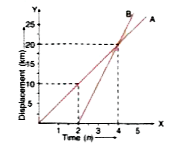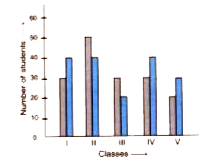When is the work done in the following situation:
(i) A boy pushing a wall
(ii) A girl carrying a school bag on her shoulders
(iii) A stone falling freely
(iv) A boy climbing up the stairs.
(i) and (ii)
(i) and (iii)
(ii) and (iv)
(iii) and (iv)
To determine when work is done in the given situations, we need to analyze each scenario based on the definition of work in physics. Work is done when a force causes an object to move a certain distance in the direction of the force. The formula for work is:
Work=Force×Displacement×cos(θ)
where θ is the angle between the force and the direction of displacement.
Let’s evaluate each situation step by step:
Step 1: A boy pushing a wall
- Force: The boy applies a force on the wall.
- Displacement: The wall does not move (displacement = 0).
- Work Done: Since the displacement is zero, the work done is:
Work=Force×0=0
- Conclusion: No work is done.
Step 2: A girl carrying a school bag on her shoulders
- Force: The girl exerts an upward force to hold the bag.
- Displacement: If she walks forward, there is horizontal displacement.
- Work Done: The force exerted is vertical (upward) while the displacement is horizontal. Since the angle θ between the force and displacement is 90 degrees:
Work=Force×Displacement×cos(90∘)=0
- Conclusion: No work is done.
Step 3: A stone falling freely
- Force: The gravitational force acts on the stone.
- Displacement: The stone moves downward due to gravity.
- Work Done: The force and displacement are in the same direction (downward), so:
Work=Force×Displacement×cos(0∘)=Force×Displacement
- Conclusion: Work is done.
Step 4: A boy climbing up the stairs
- Force: The boy applies a force to lift his body against gravity.
- Displacement: He moves upward as he climbs the stairs.
- Work Done: The force (upward) and displacement (upward) are in the same direction:
Work=Force×Displacement×cos(0∘)=Force×Displacement
- Conclusion: Work is done.
Final Answer
Based on the analysis:
- Work is done in situations (iii) a stone falling freely and (iv) a boy climbing up the stairs.
- Therefore, the correct answer is: (iii) and (iv).
---
- Force: The boy applies a force on the wall.
- Displacement: The wall does not move (displacement = 0).
- Work Done: Since the displacement is zero, the work done is:
Work=Force×0=0
- Conclusion: No work is done.
- Force: The girl exerts an upward force to hold the bag.
- Displacement: If she walks forward, there is horizontal displacement.
- Work Done: The force exerted is vertical (upward) while the displacement is horizontal. Since the angle θ between the force and displacement is 90 degrees:
Work=Force×Displacement×cos(90∘)=0
- Conclusion: No work is done.
- Force: The gravitational force acts on the stone.
- Displacement: The stone moves downward due to gravity.
- Work Done: The force and displacement are in the same direction (downward), so:
Work=Force×Displacement×cos(0∘)=Force×Displacement
- Conclusion: Work is done.
- Force: The boy applies a force to lift his body against gravity.
- Displacement: He moves upward as he climbs the stairs.
- Work Done: The force (upward) and displacement (upward) are in the same direction:
Work=Force×Displacement×cos(0∘)=Force×Displacement
- Conclusion: Work is done.
Based on the analysis:
- Work is done in situations (iii) a stone falling freely and (iv) a boy climbing up the stairs.
- Therefore, the correct answer is: (iii) and (iv).
Topper's Solved these Questions
- ENERGYBOOK - ICSECHAPTER - ENERGYEXERCISE - EXERCISE 4.1 (OBJECTIVE TYPE QUESTIONS) Match the Column - E
1 Videos
- ENERGYBOOK - ICSECHAPTER - ENERGYEXERCISE - EXERCISE 4.1 STUDY QUESTIONS
6 Videos
- ENERGYBOOK - ICSECHAPTER - ENERGYEXERCISE - EXERCISE 4.1 (OBJECTIVE TYPE QUESTIONS) - C
5 Videos
- ELECTRICITY BOOK - ICSECHAPTER - ELECTRICITY EXERCISE - Picture Study
5 Videos
- FORCE AND PRESSURE BOOK - ICSECHAPTER - FORCE AND PRESSURE EXERCISE - Picture Study
4 Videos
Similar Questions
A boy carrying a school bag on his shoulder does no work . (Why)
View SolutionState whether work is done or not ,by writing yes or no,in following cases:
(a) A man pushes a wall
(b)A coolie stands with a box on his head for 15 min.
(c )A boy climbs up 20 stairs.
View SolutionThe weights of 60 boys are given in the following distribution table:Find
(i) Median (ii) Lower quartile (iii) Upper quartile (iv) Inter quartile range
View SolutionWrite the negation of the following statements :
(i) ram is a good boy.
(ii) the number 3 is smaller than 5.
(iii) the length of two diagonals of a square are equal.
(iv) the smallest natural number is one.
View SolutionFig 2.26 shows the displacement-time graph for the motion of two boys A and B along a straight road in the same direction. Answer the following:
(i) When did B start after A ?
(ii) How far away was A from B when B started?
(iii) Which of the two has greater velocity ?
(iv) When and where did B overtake A ?

View SolutionExmine the given graph carefully.

In the graph show above represents the number of girls in a particular class and represents the number of boys in the same class.
Read and answer the following questions.
(i) Which class has the least number of students ?
(ii) Which class has maximum number of students ?
(iii) What is the ratio between the number of girls and the number of boys of class V.
View SolutionFind out the correct match from the following :−
(i) Larynx -sound box
(ii) Trachea - complete cartilagenous rings
(iii) Epiglottis -elastic cartilagenous flap
(iv) Alveoli - very thin, irregular walled, non-vascularised bag like structured
(v) Pleural fluid - reduces friction on the lung surface
View SolutionMeeta father was driving her to the school. At the traffice signal she noticed that each traffic light was made of many tiny lights instead of a signal bulb. When Meeta asked this question to her father's he explained the reason for this.
Answer the following question based on above information:
(i) What were the values displayed by Meeta and her father?
(ii) What answer did Meeta's father give?
(iii) What are the tiny light in traffice signal called and how do these operate?
View SolutionFind the number of ways in which 5 boys and 5 girl be seated in a row so that (i)No two girls may sit together (ii)All the girls sit together (iii)all the boys sit together. (iv)All the girls are never together.
View SolutionCattle husbandry is done for the following purposes
(i) Milk production (ii) Agricultural work
(iii) Meat production (iv) Egg production
View Solution
